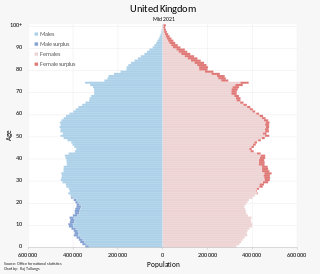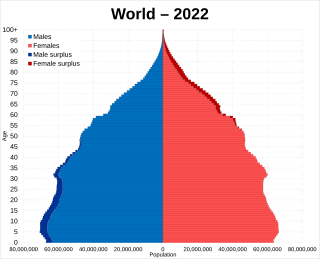Related Research Articles

After registering steady increases during the Soviet period, the population of Armenia declined from its peak value of 3.633 million in 1992 to 2.986 million in 2017.

Sources disagree as to the current population of Eritrea, with some proposing numbers as low as 3.6 million and others as high as 6.7 million. Eritrea has never conducted an official government census.

India is the most populated country in the world with one-sixth of the world's population. According to official estimates in 2022, India's population stood at over 1.42 billion.

Laos is a country in Southeast Asia. The country's population was estimated at about 7.43 million in 2021, dispersed unevenly across the country. Most people live in valleys of the Mekong River and its tributaries. Vientiane Prefecture, which includes Vientiane, the capital and largest city of the country, had about 569,000 residents in 1999. The country's population density is 23.4/km2.

This article is about the demographic features of the population of the historical territory of Latvia, including population density, ethnic background, education level, health of the populace, economic status, religious affiliations and other aspects of the population.

The population of the United Kingdom was estimated at over 67.0 million in 2020. It is the 21st most populated country in the world and has a population density of 270 people per square kilometre, with England having significantly greater density than Wales, Scotland, and Northern Ireland. Almost a third of the population lives in south east England, which is predominantly urban and suburban, with about 9 million in the capital city, London, whose population density is just over 5,200 per square kilometre.

This article is about the demographic features of the population of Albania, including population density, ethnicity, education level, health of the populace, economic status, religious affiliations and other aspects of the population. The demography of the Albania is monitored by the Institute of Statistics of Albania. The institute has performed demographic censuses since the 1924s. The latest census in Albania was performed in April 2011, and has been deemed as unreliable both within and outside Albania.

The demographics of Belarus is about the demographic features of the population of Belarus, including population growth, population density, ethnicity, education level, health, economic status, religious affiliations, and other aspects of the population.

The demography of the Republic of Bulgaria is monitored by the National Statistical Institute of Bulgaria.

Demographics of Wales include the numbers in population, place of birth, age, ethnicity, religion, and number of marriages in Wales.
A population decline in humans is a reduction in a human population size, either caused by higher mortality rates, emigration or reduced birth rates. Over the long term, stretching from prehistory to the present, Earth's total human population has continued to grow; however, current projections suggest that this long-term trend of steady population growth may be coming to an end.

An urban area, built-up area or urban agglomeration is a human settlement with a high population-density and an infrastructure of built environment.

Šalčininkai is a city in Vilnius County, Lithuania, situated south-east of Vilnius, near the border with Belarus.

The 1989 Soviet census, conducted between 12 and 19 January of that year, was the last one that took place in the Soviet Union. The census found the total population to be 286,730,819 inhabitants. In 1989, the Soviet Union ranked as the third most populous in the world, above the United States, although it was well below China and India.

Saint Petersburg is the second largest city in Russia, after Moscow and the fourth most populous city in Europe.
Following centuries of relative ethnic diversity, the population of modern Poland has become nearly completely ethnically homogeneous Polish as a result of the radically altered borders as well as both the Nazi German and Soviet Russian or Polish Communist campaigns of genocide, expulsion and deportation during and after World War II in the country, in addition to the earlier long processes of Polonization. Nevertheless, multiple ethnic minorities of various origin remain in Poland today, including some newly arrived or grown in size in recent decades.

Earth has a human population of over 8 billion as of 2023, with an overall population density of 50 people per km2, excluding Antarctica. Nearly 60% of the world's population lives in Asia, with almost 2.8 billion in the countries of India and China combined. The percentage shares of India, China and rest of South Asia of the world population have remained at similar levels for the last few thousand years of recorded history. The world's literacy rate has increased dramatically in the last 40 years, from 66.7% in 1979 to 86.3% today. Lower literacy levels are mostly attributable to poverty. Lower literacy rates are found mostly in South Asia and Sub-Saharan Africa. The world's largest ethnic group is Han Chinese, constituting over 19% of the global population in 2011. In terms of the largest number of native speakers, Mandarin is the world's most spoken language.
The 2014 Moldovan census was held between 12 and 25 May 2014. It was organized by National Bureau of Statistics of the Republic of Moldova.
References
- 1 2 STATISTIKOS DEPARTAMENTO GENERALINIO DIREKTORIAUS ĮSAKYMAS DĖL LIETUVOS RESPUBLIKOS 2011 METŲ VISUOTINIO GYVENTOJŲ IR BŪSTŲ SURAŠYMO LAPO (VIENKARTINIO) FORMOS PATVIRTINIMO (GENERAL DIRECTOR OF THE STATISTICS DEPARTMENT ORDER ON THE APPROVAL OF THE 2011 GENERAL POPULATION AND HOUSING CENSUS OF THE REPUBLIC OF LITHUANIA (ONE-TIME) FORM)
- 1 2 2011 Census summary (in Lithuanian and English)